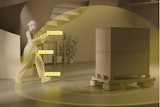Imagine making a workplace change that would provide a positive environmental benefit, cut lighting costs by more than 50%, resulting in an annual savings of approximately $40,000 per year, and improve site quality. Sound too good to be true? That has been the exact result of Nashville Wire Products' (NWP) decision to change to a lighting system from Orion Energy Services, Plymouth, WI, at its Driftwood facility in Nashville, TN.
"A lot of people were skeptical, I think," commented Daron Whitehead, NWP design engineer. "When I told everybody the plan was to save money by changing out our light fixtures, people kind of said 'you're going to do what, now?' But when I explained to them that we would be cutting our wattage in half, it started to make sense to them, especially after I showed them the numbers."The numbers had been supplied by Ken Avery, president of Energy Solutions Inc., an energy consultant firm. "Almost every plant layout changes over time, with the lighting taking on more and more of an improvised character," Avery said. "For that reason, there's usually substantial benefit from a thorough review of the existing lighting layout."
Before recommending any course of action, Avery and Whitehead took light readings, consulted plant area managers and employees about light levels, and discussed obtaining more effective light placements. To substantiate the cost-saving projections, Energy Solutions installed ten light fixtures on a circuit along with an energy meter to compare the new system's power consumption to the old.
"Ken gave me his estimate of what we could save and what we could accomplish," Whitehead said. “When I went through the numbers, the savings were there, it's a fairly linear, straightforward calculation, and the savings were real." After the retrofit was complete, Whitehead and Avery verified power reduction estimates with electric meter readings.
The change, which substantially increased light levels throughout the Driftwood plant, resulted in a lighting power reduction from 1,134,939 kilowatt-hours (kWh) per year to a projected 549,403. This led to a 52% drop of 563,000 kWh, worth $40,000 per year.
For independent verification of the meter readings, Nashville Wire Products utilized a service called "Power Tracker," provided by the Nashville Electric Company. This service indicated a usage drop of 80 KW as soon as the project was complete.
These figures give the project a cash return on investment (ROI) of 57.1% and 21-month payback. All told, Nashville Wire replaced 374 metal halide (MH) and outmoded fluorescent task lights with 326 T8 fluorescent fixtures. Numerous task lights were eliminated.
"It's made such a big difference in the morale, not that we had any problems to begin with. It just seems fresher and I think people function better in a well-lighted area," said Whitehead.
"One thing I especially like about the new fixtures," Whitehead said, "is that they are hung by jack chains and have plugs. So if we ever need to move or change a fixture it's not permanently tied in. We can just unplug it and move it where we need it."
Aside from the work-related and financial benefits for NWP, the power reduction also provides a significant environmental benefit for the local environment. The 563,000 kWh saving will mean, according to Federal EPA formulas, that some 434 tons of carbon dioxide and 118 tons of carbon, products of power plant generation, will not be released into the atmosphere each year. It is also the equivalent of a 107-acre forest, removing 83 cars from the road and saving 53,231 gallons of gasoline per year, according to the EPA.
The savings and environmental benefits are possible because Orion Illuminator fixtures have been engineered to use a specially formed, highly reflective surface to utilize light emitted from all sides of a fluorescent tube and direct it downward to where it is usable. As a result, The Illuminator provides more light from far less energy than standard fixtures.
The Illuminator is typically used with T8 full-spectrum fluorescent tubes and electronic ballasts. As a result, Orion systems turn on instantly, operate at 130° Fahrenheit, and provide a much more natural light than older fluorescent types, and a much longer life and lamp cost than HIDs.
“Here, however, Nashville Wire Products not only saved substantially on their power costs and got the better lighting they were looking for but provided a significant environmental benefit as well. They also took a significant amount of power off the grid. That tends to keep electric rates stable -- and that's an issue we’re all facing," commented Orion president Neal Verfuerth.
| Light-level readings in the Driftwood facility had seen lows of 5, 6 and 8-footcandles, with an overall average of 18. Readings afterward rose to 25, 45, and 49 respectively, with the overall plant average in the low 40s. The electric power used for lighting, however, dropped by 52% after the change to Orion. Click here to enlarge |
Nashville Wire Products, Inc.
https://www.nashvillewire.com/
615.743.2500



















